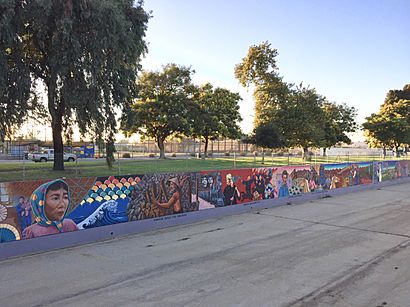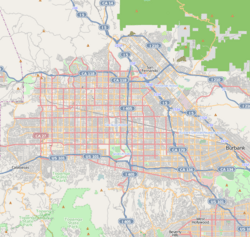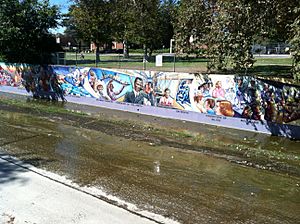Great Wall of Los Angeles facts for kids
Quick facts for kids The Great Wall of Los Angeles |
|
|---|---|

Section of The Great Wall of Los Angeles, September 2018
|
|
| Artist | Judy Baca |
| Year | 1978 |
| Type | Public Art, Mural |
| Medium | Paint on Concrete |
| Subject | History of California |
| Dimensions | 4.0 m × 840 m (13 feet × 2754 feet) |
| Location | Los Angeles |
| 34°10′34″N 118°24′51″W / 34.17620°N 118.41408°W | |
| Website | |
|
The Great Wall of Los Angeles
|
|
| Location | Coldwater Canyon Avenue Valley Glen, Los Angeles, California, United States |
| NRHP reference No. | 100001602 |
| Added to NRHP | September 18, 2017 |
The Great Wall of Los Angeles is a huge mural painted on the concrete walls of the Tujunga Wash in Los Angeles, California. It was designed by artist Judy Baca and created with the help of over 400 young people and artists. This amazing artwork is also known as The History of California. It was added to the National Register of Historic Places in 2017, which means it's a very important historical site.
Contents
About the Great Wall Mural
The Great Wall is located in Valley Glen, a community in the San Fernando Valley. You can find it along Coldwater Canyon Avenue. The mural is painted on the concrete sides of the Tujunga Wash, which is part of Los Angeles's water drainage system.
This mural is 13 feet (about 4 meters) high. It stretches for an incredible 2,754 feet (840 meters), covering more than six city blocks! This makes it one of the longest murals in the entire world.
Stories on the Wall: California's History
The Great Wall of Los Angeles tells the history of California. But it shows this history "through the eyes of women and minority groups." This means it highlights stories that are often not told in traditional history books.
The mural starts with ancient times, showing native wildlife and the creation story of the Chumash people. Most of the panels then focus on events from the 20th century. These include:
- The important work of Chinese laborers in the United States.
- The arrival of Jewish refugees who found a new home in Los Angeles.
- Families moving to California during the Dust Bowl and the Great Depression.
- The internment of Japanese Americans during World War II.
- The Zoot Suit Riots and the Freedom Riders who fought for civil rights.
- The story of Biddy Mason, a formerly enslaved woman who became a wealthy landowner.
- The birth of rock and roll music.
- The growth of suburbs.
- The fight for gay rights.
The mural covers California's history up to the 1950s. Each part of the wall was designed by a different artist, all guided by Judy Baca.
Why These Stories Matter
The Great Wall of Los Angeles focuses on the history of Native Americans, different ethnic and religious groups, LGBTQ people, and those who fought for civil rights. Judy Baca felt that there wasn't enough public art showing the diverse heritage of Los Angeles. The mural was created during the Chicano Movement (1960s-1980s), which was a time when Mexican Americans were fighting for their rights. Today, the mural is seen as a very important cultural landmark.
Because the mural shows historical events, it's even used in lessons at Grant High School and Valley College.
Art Style of the Mural
The style of the mural is called Social Realism. This means the art shows real-life events and social issues. The Great Wall of Los Angeles doesn't avoid difficult parts of history. The way the mural is designed, with its sweeping lines and sense of movement, also makes it very appealing to look at.
How the Mural Was Created
The idea for the mural first came up in 1974. Judy Baca was asked by the Army Corps of Engineers to help make the flood-control channel look better. Baca saw the plain concrete wall as "a scar where the river once ran." In 1976, she decided to create an epic history of Los Angeles County, starting from ancient times. She did a lot of research on her own.
In 1977, Baca studied mural techniques in Mexico. She learned about how murals are different from regular paintings and how to preserve them.
After her studies, Baca and her team turned an old police station into their mural headquarters. This place became the Social and Public Art Resource Center (SPARC). It was used for workshops, storing project materials, and other programs.
Many artists helped with the project, including Isabel Castro, Yreina Cervantez, and Christina Schlesinger. With support from the City and the Corps of Engineers, work began in the summer of 1978.
Working Together on the Mural
Each part of the Great Wall of Los Angeles was developed using a process called "Imagining of Content." This process was created at SPARC. It involved:
- Doing research.
- Inviting experts in different fields.
- Working together to choose important cultural, political, and historical stories.
- Interviewing people who lived through those historical events.
This process helped make sure the stories were fair and accurate. Artists would then create sketches, get feedback, and finally transfer their designs onto the huge wall. Each section took about a year to complete.
Originally, about 80 young people were hired to help paint the mural. They worked many hours a week and earned money. These young people came from many different backgrounds. Judy Baca helped them work together peacefully, even though they sometimes came from "warring neighborhoods." She became known as the "mural lady." She taught them valuable skills like math, history, and art.
Later, more young people were hired with help from the Jewish Community Foundation. Over 400 young people helped paint the mural over six summers. Also, 40 historians and 40 artists contributed to the project.
Near the end of the project, a flood damaged the site and washed away materials. But the community quickly raised $20,000 to help the artists finish. The Great Wall of Los Angeles was completed in 1984.
Caring for the Mural and Its Future
Over the years, the mural faced damage from floods, pollution, and the sun. It needed a lot of work to be restored.
In 2011, the mural was restored. Artists and some of the original young people who worked on it came back to help. They worked long hours to bring the mural back to life.
Future Plans for the Wall
There are exciting plans for the future of the Great Wall.
- New Bridge: A pedestrian bridge is planned. This bridge will let visitors get closer to the mural and see the art better.
- More History: Plans are in the works to continue the mural beyond the 1950s! Funds have been provided to design panels for the 1960s, 1970s, 1980s, and 1990s. The goal is to make the mural a mile long.
- Visitor Area: There are also ideas for picnic tables, restrooms, and benches, making it a great place for people to visit and learn.
Words from Judy Baca
Judy Baca, the lead artist, has shared her thoughts about the mural:
- "Public art in America has taken a shift; it's basically becoming decorative. They've reduced the community process to censorship. The Great Wall, for example, could not be done today." (2000)
- "It's not just history, it's really about relationships—about connecting." (2004)
- "The people who have worked on this project gave much more than their time. They made a giant monument to interracial harmony." (2000)
Images for kids








